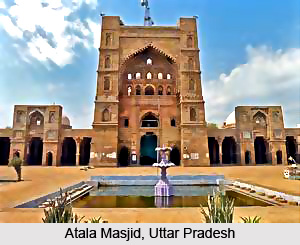 Atala Masjid is an ancient mosque and amongst the famous tourist locales of Jaunpur, a district in the Indian state of Uttar Pradesh. It belongs to the 15th century and was erected by Sultan Ibrahim between the period of 1401 and 1440, while the basic foundations of the mosque had been established by Sharqi Sultan of Jaunpur, during the regime of Tughlaq Sultan Firuz Shah III. The final construction work of Atala Masjid was accomplished in the year 1408. The architectural features of this mosque bear testimony to the age during which it had been built. The Atala Mosque is said to be an ideal instance of all types of mosques scattered across the nation and also in Uttar Pradesh. It is based at a distance of nearly 26.3 km from the north-western portion of Kirakat, 7.3 km from the north-western part of Zafarabad and 2.2 km from the north-western part of Jaunpur.
Atala Masjid is an ancient mosque and amongst the famous tourist locales of Jaunpur, a district in the Indian state of Uttar Pradesh. It belongs to the 15th century and was erected by Sultan Ibrahim between the period of 1401 and 1440, while the basic foundations of the mosque had been established by Sharqi Sultan of Jaunpur, during the regime of Tughlaq Sultan Firuz Shah III. The final construction work of Atala Masjid was accomplished in the year 1408. The architectural features of this mosque bear testimony to the age during which it had been built. The Atala Mosque is said to be an ideal instance of all types of mosques scattered across the nation and also in Uttar Pradesh. It is based at a distance of nearly 26.3 km from the north-western portion of Kirakat, 7.3 km from the north-western part of Zafarabad and 2.2 km from the north-western part of Jaunpur.
Architecture of Atala Masjid
One of the most impressive architectural characteristics is that Atala Masjid exhibits the unique architectural styles of Hindu architecture, though it is an entirely Islamic monument. It is believed that the square-shaped Atala Masjid contains traces of Hindu architectural features on most of its structure since it is located near the region of a temple dedicated to Atala Devi. Therefore, this mosque is named after the Atala Temple in Jaunpur. The construction of this temple has also been motivated by that of the Begampur Masjid, Delhi. The inclined walls, beautiful niches, wonderful beams of Atala Masjid resembled those of the various tombs, monuments and several other mosques created by Firoz Shah Tughlaq and Muhammad Shah Tughlaq.
A majestic arch is existent in the central portico of the mosque and there is a large hall which serves as the main prayer room. Atala Masjid`s three domes vary in size and the `mihrab` or niche present in one of the walls of the mosque signifies the direction of Mecca. The elaborate decorations of double-tiered corridors and the chief prayer room, along with the many other structures of the mosque are quite praiseworthy. Hindu architectural styles will be observed in the bracketed openings and a large arch separates the two pylons. Rectangular pylons exist in the central part of the `liwan` and the impact of tapering circular turrets of Tughlaqs is seen inside the premises of the mosque. Three separate gateways have been established in the southern, northern and eastern liwan.
The Atala Mosque has been declared to be a part of the List of Monuments of Archaeological Survey of India and also the List of Monuments or Sites of the Archaeological Survey of India or the Directorate of Archaeology, Uttar Pradesh. Special prayers are conducted here every Friday and the mosque also consists of a `madarsa` known as `Madarsa Din Dunia` based in the central courtyard of Atala Mosque. The mosque has been mentioned in a book `Select Views in India` authored by William Hodges.











